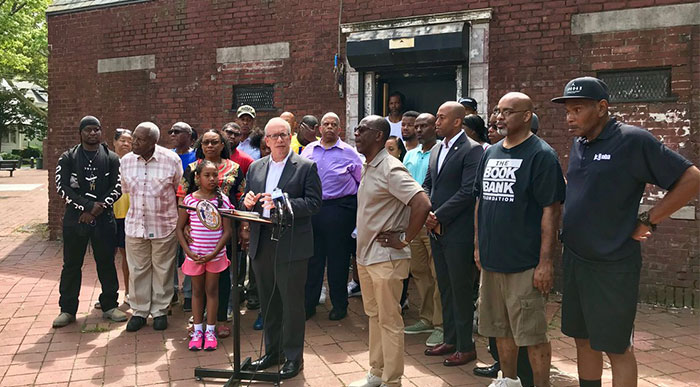Photo Courtesy of Comptroller Stringer’s Office
“The economic growth in our neighborhoods is good news, but only if it means real opportunities for the working families, seniors, and immigrants who built these communities in the first place,” Stringer said.
By Forum Staff
Long-time local residents in gentrifying neighborhoods are largely being left out of the recent economic expansion, according to a report released on Friday by City Comptroller Scott Stringer.
The updated 2018 edition of Stringer’s “Neighborhood Economic Profiles” analysis found that in the 24 neighborhoods identified as gentrifying, just one-third of net new jobs in these areas were filled by people of color, who represent the vast majority of local residents.
“The economic growth in our neighborhoods is good news, but only if it means real opportunities for the working families, seniors, and immigrants who built these communities in the first place. This report clearly shows that local residents are getting left behind as already struggling New Yorkers are finding it harder than ever to afford living here,” Stringer said. “We need to fully fund workforce development programs, build community partnerships, and prepare local residents with the necessary skills and training so that they can thrive in their growing neighborhood economies.”
The comptroller pointed out that in the 24 neighborhoods identified as “gentrifying” in the report, local employment jumped by an average of 24 percent, nearly triple the growth rates in “low-rent, non-gentrifying areas” and far outpacing those in “high rent neighborhoods.” The fastest growth was found in Claremont-Bathgate in the Bronx, Williamsburg and Crown Heights South in Brooklyn, and Central Harlem South in Manhattan, where the number of jobs rose by more than 40 percent since 2010.
Additionally, according to Stringer, high levels of job growth, especially for young employees and those in higher wage jobs, exemplify why gentrifying neighborhoods should be spaces of economic opportunity for local residents. However, the analysis found that new jobs often failed to reach local residents of color who make up the vast majority of both residents and job seekers. Additionally, these wide disparities in job outcomes suggest that gentrification may have a stronger effect on the labor market than the residential market.
Stringer’s report also provided several recommendations for connecting long-time residents to local jobs and investing in workforce development, including:
• The City should honor the goals set in its Career Pathways plan, which are currently far off-track, according to the comptroller. While the City promised to invest $60 million per year in “bridge programs” pairing academic instruction with workforce development services by 2020, as of FY 2017, only $7.5 million was budgeted.
• The City should empower the Mayor’s Office of Workforce Development, allowing it to set policy and funding priorities for the more than a dozen agencies that engage in skills-building and job placement.
• The City should develop stronger ties between community boards and nonprofits to ensure that any business or new development that comes before the boards is referred to job-placement and training organizations.
• The City should also encourage stronger partnerships between local workforce development organizations so that they can provide better end-to-end support services and work together on job placements.
• The City can help preserve longstanding neighborhood businesses by developing a “re-entrepreneur” program and online portal. These programs connect retiring small-business owners with aspiring entrepreneurs and provide guidance for transferring and reinvigorating local businesses. Introducing a Re-Entrepreneur program – as well as more effective entrepreneurship programs – can help preserve neighborhood anchors and maintain some continuity along New York’s fast-changing business corridors, Stringer noted.

